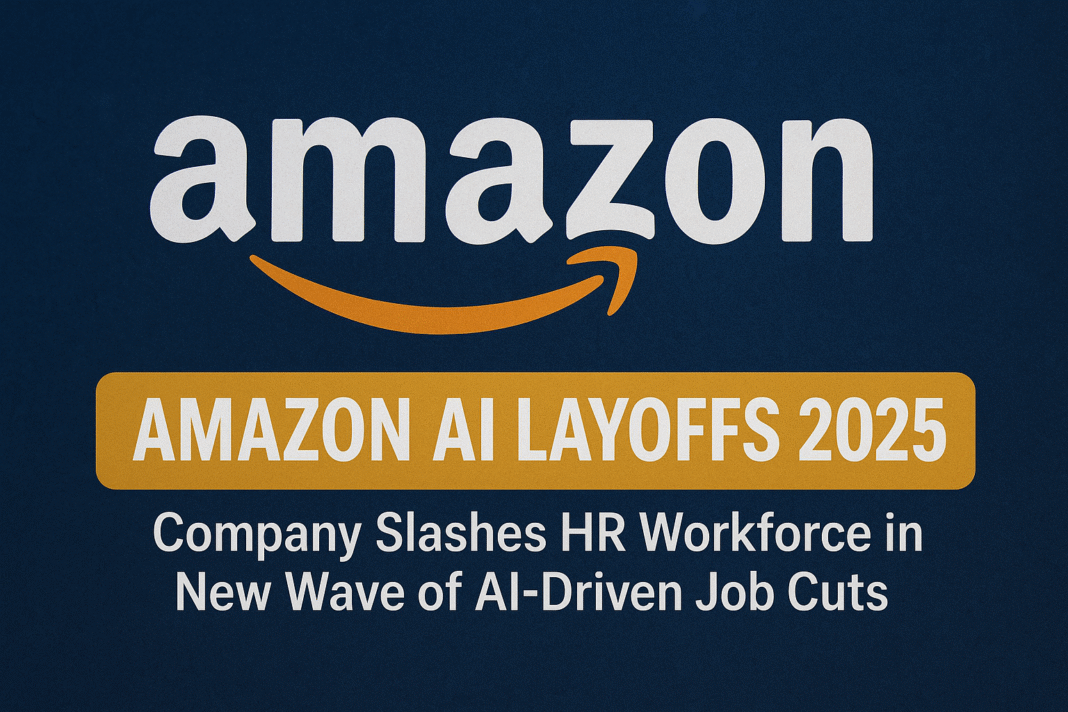Introduction

Amazon has once again made headlines—this time for another wave of job cuts. On October 15, 2025, the company announced a major reduction in its Human Resources division, internally known as People eXperience and Technology (PXT). The move marks one of Amazon’s most significant steps toward an AI-first corporate structure, signaling a massive shift in how the tech giant manages its workforce.
The Announcement from Seattle
The news broke from Seattle, WA, where Amazon confirmed that up to 15% of its HR workforce will be laid off as part of its latest cost-cutting initiative. This reduction follows a series of smaller layoffs across various units, including Devices, Wondery, and even parts of Amazon Web Services (AWS).
While Amazon hasn’t released an exact number, industry analysts estimate that thousands of employees could be affected globally.
Understanding Amazon’s PXT Division
The People eXperience and Technology (PXT) division plays a vital role in managing Amazon’s vast global workforce. It handles everything from hiring and training to employee engagement and performance systems.
However, with the growing integration of AI tools for recruitment, performance analysis, and HR automation, much of PXT’s traditional work can now be streamlined by machine learning systems.
The Scale of the Layoffs
The 15% reduction is significant given that Amazon’s HR team employs tens of thousands of staff across its global network. These cuts are not isolated—they represent a continued shift toward AI-powered efficiency, where automation replaces manual HR processes such as candidate screening, payroll processing, and employee feedback collection.
The Role of AI in Amazon’s Restructuring
AI isn’t just a buzzword at Amazon—it’s becoming the backbone of its operations. From automated logistics to customer support chatbots, AI is deeply embedded in Amazon’s infrastructure. Now, that transformation has reached corporate human resources, reshaping how the company hires, manages, and supports its employees.
Amazon’s Push Toward AI-Driven Operations
CEO Andy Jassy has been clear about his vision: AI is central to Amazon’s future. In a memo earlier this year, Jassy said,
“We expect that this will reduce our total corporate workforce as we get efficiency gains from using AI extensively across the company.”
This vision has translated into aggressive AI adoption programs, from internal management systems to predictive analytics tools that forecast staffing needs and optimize resource allocation.
Efficiency vs. Employment — The New Corporate Trade-Off
This trend highlights a tough question: At what cost does efficiency come?
While AI boosts productivity and reduces costs, it inevitably means fewer human jobs. For Amazon, efficiency now means faster decisions, fewer manual processes, and a smaller workforce.
Industry-Wide Trend in Tech Layoffs
Amazon isn’t alone in this transformation. Across the tech landscape, companies are restructuring workforces to align with AI-driven efficiencies.
Meta, Google, and Microsoft — Similar Strategies
- Meta has automated many of its marketing and analytics roles.
- Google has restructured its data teams to focus more on AI development.
- Microsoft continues integrating Copilot AI tools across departments, cutting manual workloads drastically.
These moves underscore a common theme—AI is not just a tool, it’s a workforce strategy.
Employee Reactions and Company Culture
Inside Amazon, reactions are mixed. Some employees see this as a natural evolution in the tech world, while others fear job insecurity and reduced human connection at work.
Former PXT employees have voiced concerns that AI can’t replace the empathy and personal touch crucial to HR. Yet Amazon maintains that AI will augment, not fully replace, human roles—though the layoffs suggest otherwise.
Economic and Social Implications
The layoffs ripple beyond Amazon’s walls. Thousands of displaced employees mean a broader impact on job markets, especially in cities where Amazon has large operations. On the flip side, AI-related roles—like data engineers, AI ethicists, and automation managers—are seeing a surge in demand.
The Future of HR in the AI Era
Traditional HR roles are evolving fast. AI tools can now handle onboarding, resume screening, and even employee well-being analysis. The HR professional of the future will likely be an AI strategist, not just an administrator.
Amazon’s Official Statements and Future Outlook
In his memo, Andy Jassy framed this restructuring as a “strategic evolution”, not a downsizing. He emphasized that AI will help Amazon achieve “long-term efficiency and growth.”
The company plans to reinvest savings from these layoffs into AI development, logistics innovation, and cloud infrastructure.
Lessons for Businesses and Employees
For businesses, Amazon’s pivot is a clear message: AI adoption is no longer optional—it’s essential.
For employees, it’s a reminder to adapt and upskill. Learning AI tools, automation systems, and data analytics will be crucial for future job security.
Conclusion
Amazon’s decision to cut 15% of its HR workforce marks a defining moment in the company’s evolution—and the tech industry as a whole. As AI takes the driver’s seat, traditional corporate roles are being redefined.
This isn’t just a story about layoffs—it’s about how AI is reshaping the nature of work itself. The future belongs to those who can work with AI, not against it.
FAQs
- Why is Amazon cutting HR jobs in 2025?
Amazon is reducing its HR workforce as part of its shift toward AI-driven automation, aiming to boost efficiency and cut costs. - What is Amazon’s PXT division?
PXT stands for People eXperience and Technology, Amazon’s internal HR and employee management division. - How does AI impact HR operations?
AI automates recruitment, performance tracking, and employee engagement, reducing the need for large HR teams. - Are other companies doing similar layoffs?
Yes, companies like Meta, Google, and Microsoft are also restructuring to integrate AI and reduce redundancy. - What’s next for employees affected by AI-driven job cuts?
Many may transition into AI-related roles or pursue retraining programs to adapt to new technologies.







